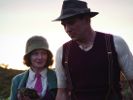Eye For Film >> Movies >> South Solitary (2010) Film Review
"This is no place for a family. It's too bloody isolated, it's where you get all the nutters."
So says Harry Stanley (Rohan Nichols), acting head keeper of the lighthouse at South Solitary Island, which he looks forward to leaving behind him once the rest of his two-year posting there is over. The "nutters" to whom he refers include the previous head keeper Grimshaw, who had committed suicide some time earlier with a stick of gelignite, and his assistant keeper Jack Fleet (Marton Csokas), a taciturn Welsh ex-serviceman who has remained on the island for eight years nursing the physical and mental scars incurred during the Great War.

It is 1928, and Harry is speaking to Meredith Appleton (Miranda Otto), who has recently arrived on the island in the company of the new head keeper, her sternly fastidious uncle George Wadsworth (played by Miranda Otto's actual father Barry). Nervous, immature and needy, Meredith has a troubled history of her own – and her status as a 35-year-old spinster marks her out, at least by the standards of the times, as damaged goods.
"I must try to remain cheerful," declares Meredith rather hopelessly in the film's opening scene, as she is rowed out on rough waters to the island's stark cliffs - and there is the sense that her relocation to this craggy, barren place represents a sort of confinement, even perhaps a punishment. After all, as Harry's prickly wife Alma (Essie Davis) so bluntly puts it: "You're never going to meet the right fellow while stuck on a rock in the middle of the ocean." And yet, in the end, South Solitary will turn out to be a place where the lonely and the forsaken can come together for unexpected companionship.
The real South Solitary Island, some 18km offshore from Coffs Harbour, was home to New South Wales' first and last kerosene lighthouse, made operational in 1880 and not converted to an automatic electric system until 1975. Today the island is accessible only by helicopter, and subject to highly changeable weather, making it a risky location for a mid-budget film shoot – so writer/director Shirley Barrett, whose 1996 feature debut Love Serenade won her the Camera d'Or at Cannes, decided instead to use the well-preserved coastal lighthouses at Cape Nelson and Cape Otway, both on the Victorian mainland, as convincing stand-ins.
The realism of these settings, and Barrett's sensitivity to the slow pace of island life, serve as contrapuntal anchor to a story that, in all its storms and madness, might be regarded as pure gothic romance. The result is a moody period piece whose titular location is all at once tangibly real and evocatively figurative. For South Solitary is a locus of extreme abandonment, solitude and alienation – as well as a place where, for all the tempestuous seas and buffeting gales, fragile lives can still be rescued from the perilous rocks just so long as a little flame is kept burning in the tower.
"Endless drudgery and tedium," is how Harry describes the life of a keeper – and, confronted with a narrative that unfolds to its own leisurely rhythms, some viewers will no doubt find themselves agreeing with his sentiment. Yet our patience is rewarded with performances from Otto and especially Csokas that subtly humanise their characters' every flaw. Meanwhile Anna Howard's cinematography is never anything less than stunning in its starkness, exposing these fragile people to the most hostile of elements. And out on South Solitary, as even the negative Harry must concede: "You do catch the odd nice sunset."
Reviewed on: 07 May 2011

















